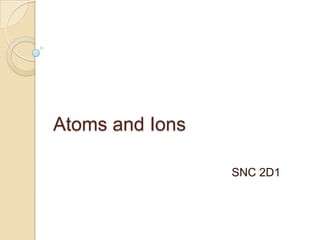
2 atoms and ions
- 1. Atoms and Ions SNC 2D1
- 2. Is drinking too much water bad for you?? Drinking too much water can cause hyponatremia ◦ Symptoms: disorientation and loss of balance Excess water can dilute the concentration of sodium in the blood to dangerously low levels (with risk of death if untreated)
- 3. What? Sodium in the blood??
- 4. No! of course not.. We are referring to sodium ions Many ions are necessary for our health Example: ◦ Calcium, phosphorus components of bone ◦ Iron help carry oxygen around body in blood
- 5. Atoms vs. Ions Atoms are electrically NEUTRAL particles with equal numbers of e- and p+ An ion is an atom that has become CHARGED by either gaining or losing electrons in its valence shell
- 6. Sodium Atom vs. Sodium Ion Sodium atoms LOSE one e- when they react with other atoms Then, each sodium ion contains 11 p+ and only 10 e- Result: sodium ions have an ionic charge of +1 (a.k.a. Na1+ or Na+) Na contains ONE electron in it’s outer orbit. Remember… STABLE orbits contain 8 electrons!! So what does this mean?
- 7. Fluorine Atom vs. Fluoride Ion Fluorine atoms GAIN one electrons when they react with other atoms Therefore, each fluoride ion contains 9 p+ and 10 e- Result: fluoride ions have an ionic charge of -1 (a.k.a. F1- or F-) F-9 contains 7 electrons in its outer orbit Remember… STABLE orbits contain 8 electrons!! So what does this mean?
- 8. Ions vs. Noble Gases Ions are STABLE Noble Gases are also STABLE Because they have filled valence shells… Which noble gas has the same # of e- as Na+? Which noble gas has the same # of e- as F- ? We say Na+ and F- is isoelectronic to Ne
- 9. DID YOU KNOW? Fluoride ions help make tooth enamel strong Fluoride is found in our tap water For decades, Canadians have been getting fewer dental cavities
- 10. Try This!! 1)Draw the B-R diagram for an Aluminum atom 2)Draw the B-R diagram for an Aluminum ion 3)Write the new symbol for the Aluminum ion 4)What is the Aluminum ion isoelectronic with? (i.e. what element has the same # of electrons as the aluminum ion?
- 11. Aluminum ion Al: 13p+, 13n0, 13e- Draw the Bohr- Rutherford diagram: 3 valence e- How to reach stability? Gain 5 or lose 3 e-? What is Al3+ isoelectronic with? Neon!
- 12. Try This!! 1)Draw the B-R diagram for a Sulfur atom 2)Draw the B-R diagram for a Sulfide ion 3)Write the new symbol for the Sulfide ion 4)What is the sulfide ion isoelectronic with? (i.e. what element has the same # of electrons as the
- 13. Sulfide ion S: 16p+, 16n0, 16e- Draw the Bohr- Rutherford diagram: 6 valence e- How to reach stability? Gain 2 or lose 6 e-? What is S2- isoelectronic with? Argon!
- 14. Hydrogen Unusual element Can form +ve and –ve ions Achieves stability by gaining one e- to fill its orbit (H-) or loses its only e- (H+)
- 15. Naming Ions Cations: positive charges Same name as the element and add the word “ion” E.g. Sodium Sodium ion Anions: negative charges Add “-ide” to the stem of the name E.g. Oxygen oxide ion E.g. Phosphorus phosphide ions